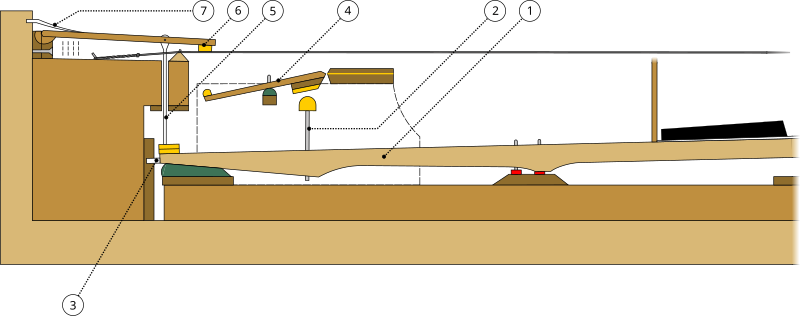Johannes Zumpe
Johannes (Johann Christoph) Zumpe (born June 14, 1726 in Fürth , burial on December 5, 1790 in London ) was a leading builder of early British square pianos , a rectangular shape of pianos with a range of about five octaves . These panel pianos had a damper lever on the left side of the case.
Life
Zumpe was trained by Gottfried Silbermann . He was then one of the so-called "Twelve Apostles", German piano makers, who emigrated to London during the turmoil of the Seven Years' War . He worked briefly at Burkhardt Tschudi before founding his own piano workshop in 1761 under the sign of the "Golden Guitar" in Princess Street, Hanover Square.
From 1769 to September 24, 1778, Zumpe had a partnership with Gabriel Buntebart. Most of the instruments he still has today are labeled “Zumpe & Buntebart”. Meincke Meyer joined Zumpe in 1778. The business was taken over in 1783 by Frederick Schoene, who advertised his piano construction as “Successors to Johannes Zumpe”, “Successor to Johannes Zumpe”.
Zumpe married Elizabeth Beeston on December 3, 1760. His will from 1784 gives his address as "Queen Charlotte Row in the parish of St Mary-le-Bow".
Pianos
Zumpes-style pianos were built from around 1760 to 1800. In Zume's day, they had a function similar to that of upright pianos today: they were more compact, did not take up as much space as a grand piano, and were easier and cheaper to manufacture compared to a grand piano-shaped instrument. Thus, they played an important role in the spread of the piano among musicians, especially among amateurs and in private households. By the time Zumpe was building his instruments, the piano had already displaced the harpsichord from its previous leading position.
Johann Christian Bach played a Zumpe instrument, and he presumably also sold it or promoted it. Although Zumpe was best known for his square pianos, other types of his instruments also survived: grand piano, harpsichord, an English guitar from 1762, and a mandora from 1764.
Game mechanics
The playing mechanics of these small instruments is known as "Simple English (Mechanics)" and is kept unusually simple, in particular far less complex than the mechanics of Christofori and Silbermann . It consists of a narrow pestle ("sticker") that simply pushes the piano hammer upwards. A wire drilled through the attachment plate lifts one of the dampers, which is suspended from a rail.
- Button ; the player presses the key lever on the right.
- Plunger ; a wire with a leather button
- Key guide made of whale bone , it is in a groove
- Hammer ; strikes the string to produce sound
- Whalebone rod , which also Mopstick called
- Damper ; in the lower position it stops the string vibrations.
- Damper spring made of whale bone
literature
- Margaret Cranmer: Zumpe, Johannes. In: Stanley Sadie (Ed.): The New Grove Dictionary of Music and Musicians. Volume 20: Virelai - Żywny. Appendixes. Reprinted with minor corrections. MacMillan et al., London et al. 1985, ISBN 0-333-23111-2 , pp. 715 f.
| personal data | |
|---|---|
| SURNAME | Zumpe, Johannes |
| ALTERNATIVE NAMES | Zumpe, Johann Christoph |
| BRIEF DESCRIPTION | British square piano maker |
| DATE OF BIRTH | June 14, 1726 |
| PLACE OF BIRTH | Fuerth |
| DATE OF DEATH | before December 5, 1790 |
| Place of death | London |
